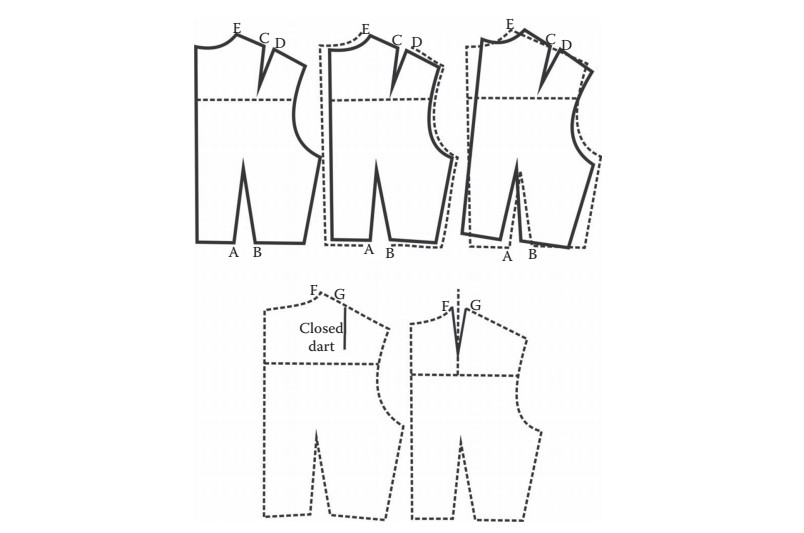
2.2.7.3 Pivot Method
The pivotal point is the designated point on the pattern that is used as a basis for the slash and spread method and the pivot method. The pivot point on

FIGURE 2.11
Front bodice with the bust circle.
the front pattern is the bust (Cooklin 1999; Crawford 2005; Beazley and Bond 2006; Gupta et al. 2006).
Front Bodice. The example of shifting of the waistline dart to the neckline dart using the pivot point method is shown in Figure 2.12.
- • The dart leg AB has to be marked on the front bodice pattern.
- • The new position of dart C has to be marked as indicated in the figure, at the neckline to which the dart needs to be shifted.
- • Tracing of the pattern from point C to point A has to be done so that the dart can be moved as shown in the figure.
- • Thumbtack the pattern at the bust point and slowly the pattern has to be moved from point B to A, thus closing the dart at the waistline.
- • Tracing of the pattern from point B to point C has to be continued and then the block bodice can be removed. Now an opening at the neckline can be observed, which can be marked as DE. This is the new dart located at the neckline.
- • Label the pivot point. This would be a guide for locating the new dart. • The midpoint of ED should
FIGURE 2.12
Pivot point method for front bodice.
- • The dart legs are drawn by joining E and D to the bust point.
- • Point F is located at 1/2″ above the bust point and the dart legs are completed as shown in the figure.
Back Bodice. The back bodice has two darts, namely, shoulder dart and the waistline dart. The shoulder dart is often used in creating new designs at the back (Cooklin 1999; Crawford 2005; Carr and Latham 2006; Gupta et al. 2006). The steps followed are shown in Figure 2.13.
• Take the back bodice block with the pivot points located on it. • Mark the dart legs as AB and CD as shown in Figure 2.13.
• Mark the location of the new dart E on the neckline.
• Starting from point E, trace the pattern toward the centre back, then to the waistline.
Trace the dart AB at the waistline and proceed to tracing the side seam, armhole and the shoulder until point D as shown in the figure. The dotted line shows the traced pattern.

FIGURE 2.13
Pivot point method for front bodice.
- • Thumbtack the pivot point corresponding to the shoulder dart and pivot the pattern thus closing the dart. See Figure 4.15.
- • Remove the pattern. You would notice the dart opening at the neckline. Mark the new dart opening as FG.
- • Locate the centre point of the dart opening FG and mark the point H.
- • The length of the dart is the same as the length of the shoulder dart. Measure the shoulder dart. Draw a line from point H parallel to the centre back line or slanted slightly away from the centre back.
- • Measure the length of the shoulder dart and mark the point on the line drawn from H. Draw the dart legs and complete the dart.

